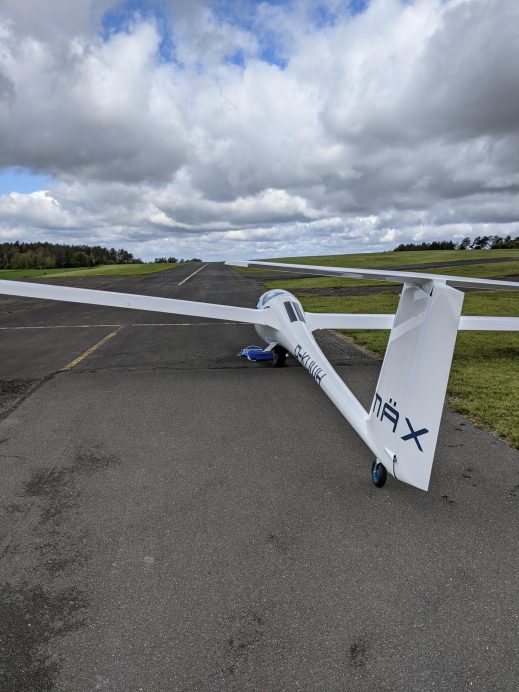The AS 33 smashes the 1000km mark for the first time!
Christian Mäx Interview about his flight.
The weather on 22.05. promised a lot, but the high wind speeds scared off for the time being.
Christian Mäx, however, saw the potential in the weather. He has the perfect aircraft for this at his disposal, the AS 33 Es.
We did an interview with him for you and asked for feedback on our new 18m flagship.
Congratulations on your first 1000 km flight with the AS 33! Was it your goal in the morning to crack the 1000?
“In the back of my mind I was thinking about how good the day was forecast to be, but there was supposed to be a lot of wind. I didn’t think about the 1000 km in these wind conditions. I looked at three weather models before the flight to understand where the good areas were most likely to be for that day and then wanted to decide in the air how well the models would fit.”
What was the launch preparation like for you? You had an ASG 29 for a long time, how does the preparation of the 29 differ from the 33?
“Essentially, both aircraft are very similar, but the weak points of the 29 were very consistently raised to a new level by you through very smart and practical solutions. This made preparation very relaxed and even easier. E.g. by the automatically switching off fuel pump I could simply connect the canister in the engine box with a hose. At the same time, I could fill the inner wings with water in the morning. Just put the hose into the new openings on the top and then everything runs by itself. In addition it must be said, I also have an electric shut-off water meter from IMI, which makes it even more relaxed. However, I did not fly the day with 600 kg, but only with 550 kg. So fueling, watering and masking all in parallel, that didn’t work on the 29 yet. Since I have a hangar space where I only put on the outer wings, I didn’t have to rig in the morning. Whereas that also works great with the new centering bolts, again a little standard gimmick from you with a lot of effect. With my 29, the canopy fell to me very easily in the wind, this is now gone. All in all, this is just great for the pilot, especially for someone like me who prepares in the morning without a helper.”
How did the flight start for you and what were your tactics?
“I set up in the dry, but shortly before takeoff, it started to rain a little. I even took off with wet wings. After the shower was over, the first good line was already visible. The aerotow was one of the gustiest I ever had from Burg Feuerstein. But with 550 kg the 33 was very agile and reactive to the flight variations even in the gusts. My tactic in the high wind speeds was first not to come low, because climbing from lower levels would certainly be exhausting. Normally I’m a pilot who doesn’t have extreme flight variations when climbing. This changed this morning, it was important to me to gain a lot of altitude in a straight flight. This worked out very well with the flap position 4. The jumps between the cloudstreets I did not fly in flat angles, but rather directly 90 degrees off to always stay in the altitude band between 1100 and 1350 meters. As I said, thermaling against the strong wind at the low base was to be avoided.”
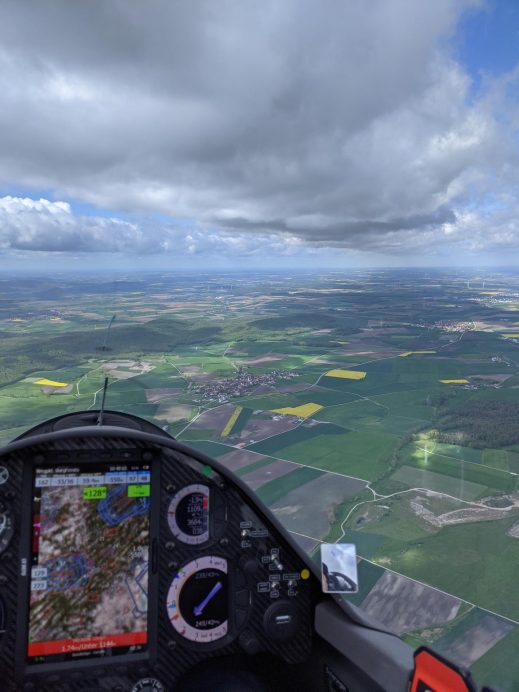
Your tactics seem to have worked, because your first leg had only 5% thermalratio over 215 km. When did the decision to turn come?
“Unfortunately, that was because I didn’t get clearance for the airspace at Reinstetten. There, visually, the lined-up clouds were actually even nicer than before. So I could have flown well into the Rhine rift valley. From Heilbronn on, unfortunately, it was no longer so good, there one did not manage to stay straight up. There I had to climb then, unfortunately. I flew between 180 and 210 km/h IAS in addition then still the 40 km/h to 50 km/h strong wind came. After the turn, it was more difficult to find the thermals or lines at high speeds with the tailwind. It has to be said that the 33 shows this much better than the 29. You notice every air movement in the wings, even if you touch a uplift lightly. In general, the 33 is clearly superior to the 29 in terms of feedback. When I got low once at Ingelfingen, I benefited immensely from the fact that the 33 gives such good feedback about the upwind. I simply went 90 degrees off course to the edge of the sun and the 33 showed me extremely well where to go up. This is besides the super performance the main advantage over the 29.”
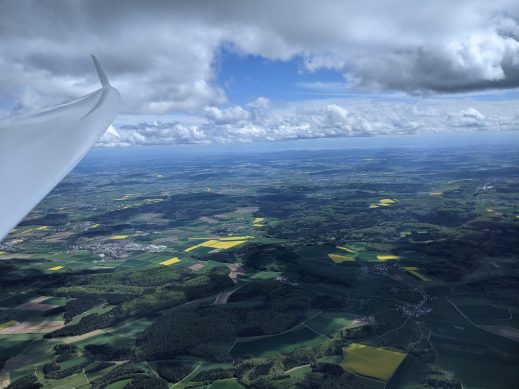
At Hohenfels - at the end of the leg - you decided to fly to the Alb - how did that decision come up?
“Actually, I wanted to go further into the Upper Palatinate, but Hohenfels also has an EDR. After I already had problems with Karlsruhe, I didn’t bother to ask if it was active. Afterwards I found out that Hohenfels was not active and I could have flown further in the direction of Oberpfalz. There I had seen then on the satellite picture in the LX9000 that the Alb was very well developed. Down there, however, it did not go against the wind without thermaling, because the distances between the thermals were now much further apart with the increased base. At that time I also still had the Bundesliga in mind, but if you are on your upwind leg at the best time of the day, that is of course not helpful for the Bundesliga.
The Alb then went very well. As you can see in the statistics, this was thermally my best leg with 2.9 m/s average climbs. Here the 33 could really show its strengths. In the uplifts, the water was virtually non-existent in the climb. In the forward glide, the high wing loading did the rest. Here you could see that the approach that you have followed with the 33 wings is working because it was very good in the climb and in the glide forward within the Champions League.
The goal of the leg was actually Klippeneck. But there the clouds were very frayed and it was already relatively late. I had the good thermals at my back and decided not to fight my way to Klippeneck. The base had already risen to 2400 m at that time. So I turned around a bit west of Albstadt.
From Ulm on I didn’t get to the base anymore, but since the planes coming towards me from the very good optics were also only at my altitude, the signal had come for me: I must now carefully take off the throttle. In these moments, one must not be unsettled by aircraft coming towards one at high speed. From the climb values, the leg was clearly weaker with 2 m/s. It went then also only up to 2100 m high.”

How did you plan your way back home?
“Since it did not look good on the weather maps and satellite pictures in the area north of Ulm and west of Nuremberg and was predicted, the only plausible way for me was in the south past Nuremberg. Towards Regensburg, it looked very good again. I then decided to fly east of Nuremberg to the north across the wind towards home. At Greding I decided to throw out the water. I flew 90 degrees to the wind, you just can’t fly too fast past thermals. Again, I have to praise the feedback of the 33 compared to the 29 and it really can’t be mentioned enough. It showed me exactly where the thermals were and how. Also, the new setting angle of the wings to the fuselage brings great advantages for the view in the forward glide because the horizon picture is different than with a 29.
For the TMZ near Hersbruck, I got directly a clearance, here the thermals were again very reliable. At the airspace rally, the thought was then only to come home without an engine. In the north, the thermals were unfortunately weak and towards Lichtenfels it was over with the weather. Since I was outside the glide path there, I tried to feel my way to Bamberg along the load-bearing line of the ridge. With a normal turbo, I would not have done this, but after my own tests, I know that I lose about 20 m until the Es system in the 33 is on. So it is possible to fly calmly along the edge. In the end, I was able to hit a thermal at the edge and fly home.”
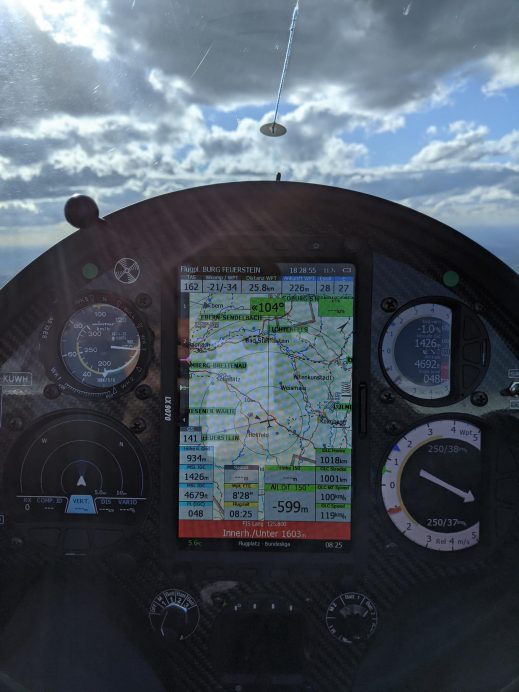
A 9 hour flight is very demanding. How did you cope with it?
“With 1.9 m distributed over long legs and a short upper body, it is not so easy for me to find a glider with comfortable space and seating position. But the ergonomics in the 33 are perfect. It is helpful that the stick on the ground is somewhat adjustable. This results in a very good arm position, which is very important on long flights. Also positive is that due to the new sealing and cockpit exhaust, not only is the noise level quiet, but the tight cockpit also dampens the temperatures. During the landing, it was turbulent again due to the wind. But that was no problem thanks to the landing position of the flaps and the large airbrakes.”
After the hours and kilometers this year, what is your conclusion about the AS 33?
“The 33 makes it possible to fly the long lines and to find the thermal in important situations. The glide performance and ergonomics of the AS 33 are outstanding. You can tell that the new wing was the right way to go. Working with your mixer system, I can circle the 33 much slower without stalling, even with water, compared to similar gliders. But the water also runs out very quickly when you open the taps of the new system. At the moment there is not so much mosquito pollution, but the integrated bug wipers run just perfectly. You can see that a lot of experience has gone into perfecting the system and that you consistently take up your customers’ points. I have not seen any integrated bug wipers that run and function so well. The extra effort with the special plaster coating was really worth it.
I am also enthusiastic about the retractable tail wheel. The visibility during taxiing through the high wheel is very good. The distance from the fuselage also prevents all the dirt from takeoff and landing from splashing onto the tail. Dismantling is also totally easy. The 33 comes with the tail dolly in the trailer, which means I don’t have to worry about the tail wheel, I can also inflate the wheel in the dolly and can check it properly during pre-flight inspection. All in all, I think you have to attach and detach the dolly much less often and thus save the scratches from mounting.
And otherwise, it is just a sneak plane with the usual ingenious processing.
Many thanks for this plane and the fast service on Friday! That your employee, who had his birthday on this Friday to take care of me until late afternoon, I also think is amazing!“
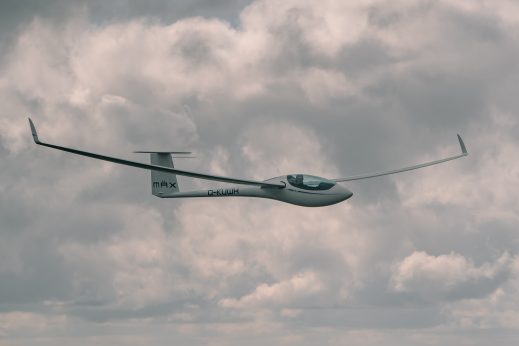
So far Saturday also looks good, will you directly add a thousand?
“Yes the weather looks really good, but I am scheduled as a coach on the D-Kader training camp. It will be hard to get rid of me, I can only encourage everyone else to try it and whoever wants to can also try it from the thermal paradise Feuerstein, the flight school tows 7 days a week and is happy about every guest, gladly also with their own airplane.”
Thank you for your time Christian and have fun at the training camp!
For everyone that is interested you can see the flight here:
1,032 km / Christian Mäx / Burg Feuerstein 22/05/2021 (weglide.org)


